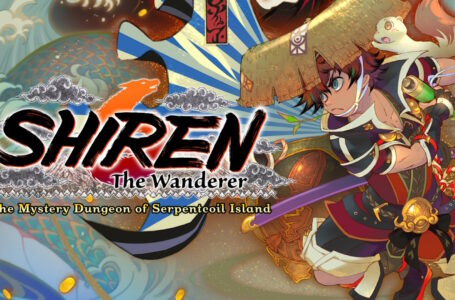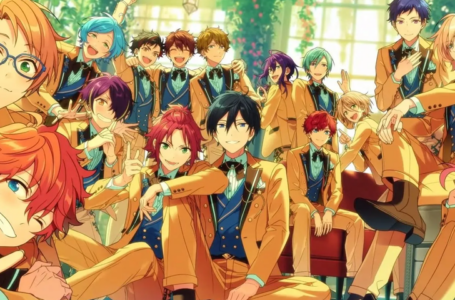Taking a first look at Kenka Bancho Otome’s manga adaptation
Kenka Bancho Otome is an otome spin-off based on the Kenka Bancho series of beat ’em up games. The IP has sadly stayed locked in Japan for the most part, aside from the third entry in the mainline series for PSP, Kenka Bancho: Badass Rumble, getting a surprise localisation.
Kenka Bancho Otome was written and illustrated by Chie Shimada, and has been one of the most-requested otome game localisations for years now. It’s not hard to see why, when its main character is the most physically strong heroine we’ve ever seen in the otome sector, and the rest of the cast is made up of characters who are effortlessly endearing and absolutely loveable. On top of all that, we have the ever-intriguing premise of a hidden identity storyline!
When Spike Chunsoft posted a Twitter poll back in 2016 asking the western audience which of their titles they’d like to see localised for Steam, Kenka Bancho Otome won by a notable margin. Sadly, nothing came of it, and when quizzed about it a couple of years later, the company’s response left a lot to be desired. Regrettably, that means English-speaking otome fans are still deprived of the game itself — though the anime and manga adaptations did at least make it over.
I thought we’d take a look at the manga adaptation specifically, since the anime fumbles with delivering a sense of coherent story progression when its runtime is only 8 minutes per episode. The art direction is also somewhat lacking for everything outside of the main characters, with background characters simply being depicted as grey, faceless figures, and the animation doing little to impress even with all the fight sequences.
Welcome to THE gender-bending, delinquent otome classic
Kenka Bancho Otome’s first manga volume covers certain story beats of the original game to set up the world, relationship dynamics, the characters’ motivations, and give us a general idea of what to expect in a condensed retelling of the game’s common route.
Heroine Hinako Nakayama is thrown to the lions as soon as you turn the first couple of pages. She’s on her way to her first day at high school when she bumps into a boy who looks remarkably similar to her — and, in the process, sends him flying off into the distance just from the impact of their bodies bumping into one another.
So there’s our first humorous look at Hinako’s natural knack of being able to body others — she is unassumingly strong. We’re led to believe that she grew up in an orphanage and grew stronger in order to fight back against those who picked on her for being a smaller girl. It seems obviously silly given her tiny frame, but the bio sections in the corner of various pages throughout the manga help flesh this out a bit more by describing her martial arts training.
Regardless, it is certainly entertaining to see her put the guys in their place, and especially when they deserve it — but more on that shortly.
At the same time, she has her own sense of agency and a solid character arc that concerns her accepting her strength as something to be proud of rather than something that causes trouble. She has been unable to make friends, and has been lonely ever since her childhood. It’s gotten so bad that when anyone lays a finger on her, she goes into defensive mode — often at the expense of characters such as Totomaru, who tend to suffer for nothing more than giving her a friendly pat.
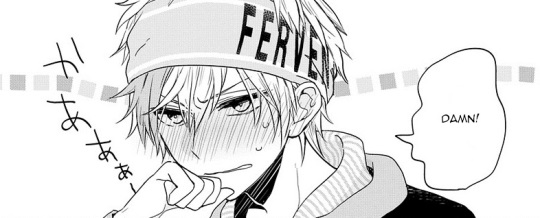
She fears attending a normal high school due to her scary strength, but she ends up not attending a normal high school. Instead, she’s dragged into an all-boys school, and one filled with delinquents, at that. But at Shishiku Academy, her true self begins to thrive as she learns to accept herself for her strength rather than shunning it. She learns to balance feminine and masculine traits, with her brute strength often juxtaposed by how kind and caring she is towards others — a trait that has one of the game’s love interests immediately swooning.
Everything about this delinquent romance story had me squealing — especially when the one most susceptible to Hinako’s unintentional cuteness manages to get the better of her.
Love interests we’d love to know better
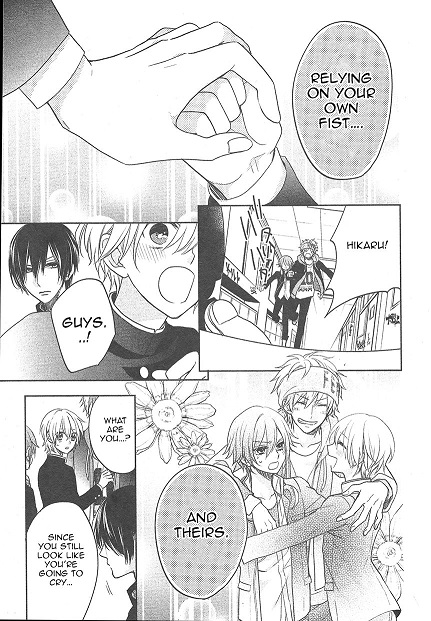
In the first volume, we’re introduced to the majority of the love interests from the original game, two of whom form the main friendship group with Hinako and help her realise her dream of living an ideal school life.
She meets Minowa Totomaru first in the Academy’s opening ceremony, which turns into an all-out brawl. His route would likely be the first I would play in the original game, because he’s a loveable and protective dork.
He isn’t bright, but he makes up for that weakness with his honesty, bravery, and the way in which he is a good-natured, friendly individual. He’s quick to defend Hinako as he strongly believes in standing up for those who appear weaker than himself — and he’s unable to deny her attractiveness, despite her posing as a boy.
As a result, he can therefore be seen blushing in almost every single panel of the volume, and for that reason alone, reading the manga was a constant treat.
Takayuki Konparu is pretty much the literal opposite to Totomaru, sticking to himself with a standoffish and stoic attitude, but he is also fiercely loyal. His design is the most bishounen of the lot, appearing atypical for delinquent male characters who tend to get into fights. He’s said to be the strongest first-year; so strong, in fact, that he rarely actually fights, because supposedly no-one can beat him when he’s being serious.
While a misunderstanding over someone punching his younger brother sees his relationship with Hinako get off to a rocky start, they reconcile quickly when Hinako demonstrates genuine concern for what has happened and compliments Takayuki’s brotherly nature.
This renews Takayuki’s opinion of Hinako, leading to him declaring that she is actually the strongest first-year any time someone tries to talk up his abilities. This, of course, backfires and ends up making Hinako a target during a social event where students have to obtain each other’s badges.
Story reveals come thick and fast in the first volume of Kenka Bancho Otome’s manga, which makes sense given that it is an adaptation of the original game’s common route. That boy Hinako first bumps into turns out to be her long-lost twin brother Hikaru Onigashima, heir to the Onigashima yakuza clan. He convinces Hinako to take his place at school — hence her attendance at an otherwise all-boys school, posing as a boy — because he detests fighting and the yakuza.
Hinako and Hikaru are polar opposites in terms of backgrounds, ideals and attitudes, meaning Hinako is actually much better suited for the position at Shishiku Academy. Thus, Hikaru tasks her with climbing the ranks of the Academy to make an impression on his yakuza family by becoming the number one student. Hinako gladly accepts simply because of their blood relationship between one another, thereby emphasising how lonely her life has been up until this point: she grasps this connection wholeheartedly, despite it leading her life down a strange path.
Beyond the first years, Hinako also has to contend with the strongest second years at the school: namely, Yuta Mirako and Rintaro Kira.
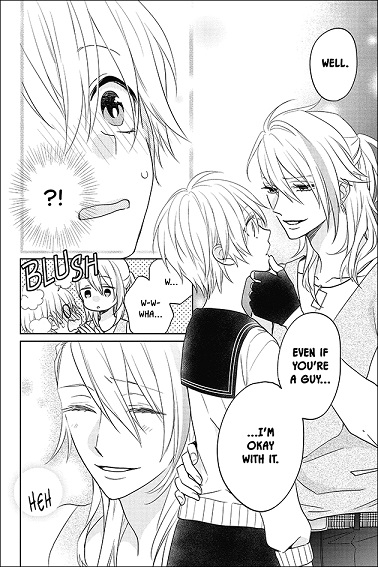
Of these two, Yuta is the most perceptive one; he’s adamant that Hinako is a girl because of his experience of being quite the ladies man. He leads another life as a popular idol, after all, and he rivals Rintaro in strength.
His suspicions towards Hinako furthers pit the pair against one another as Yuta questions why Rintaro is so protective of her, when this seems quite out of character for him. He tries multiple times to confirm her gender — but is always shut down in his advances.
Yuta has one of the most contained backstories depicted in the Kenka Bancho Otome manga. It seems he was once betrayed by one of his male friends so that said individual could score a cheap victory over him. This ended up turning his entire group of friends against him, as he had never been defeated in a fight before.
As a result, he became sad and bitter when seeing groups of male friends, and believes himself unable to feel a sense of camaraderie with fellow male students. Consequently, he latches on to his female fans, but fears being abandoned by those who look up to him — a situation highlighted when a group of male students attempt to invade a solo concert he is performing.
Hinako, Totomaru and Takayuki all pose as females to fend off the attack and defend Yuta’s fans, allowing him to perform; Rintaro, meanwhile, takes to the sound booth to regain control of the situation. The result is that Yuta feels incredibly touched by people doing this for him — and ultimately this leads to another new friend joining the party.
Finally, we come to poster boy Rintaro, whose star quality is immediately evident. He clearly has both an affinity and a history with Hinako, giving the pair understandable, touching emotional motivations and a sense of agency. His first encounter with Hinako makes this very clear — he lingers and caresses her face, and subsequently shows himself to be a loner type who avoids fights, instead being more often than not seen watching over Hinako.
It’s eventually revealed that Rintaro is the one Hinako learned self-defence from during their time in the orphanage, and he taught her the value of being a protector to those weaker than herself.
She would continue to develop this mindset once Rintaro ended up adopted, as he leaves a memento to remember him by in the form of a simple, hand-made bracelet that Hinako still wears. The two clearly cared for one another even during their childhood; Hinako cried as he left, but also wanted to see him happy. Rintaro, meanwhile, began wearing a constant gloomy, sad expression ever since his adoption — right up until realising Hinako’s true identity.
He intends to keep this knowledge to himself, and does not let on that he knows of it. He does everything in his power to instead protect her — he refuses to fight her, attempts to block attacks made at her by other students, watches her constantly from the sidelines and always appears from out of shot to prevent her body hitting the ground when she’s exhausted. He even manages to notice the differences between her and Hikaru when he’s dressed as a female.
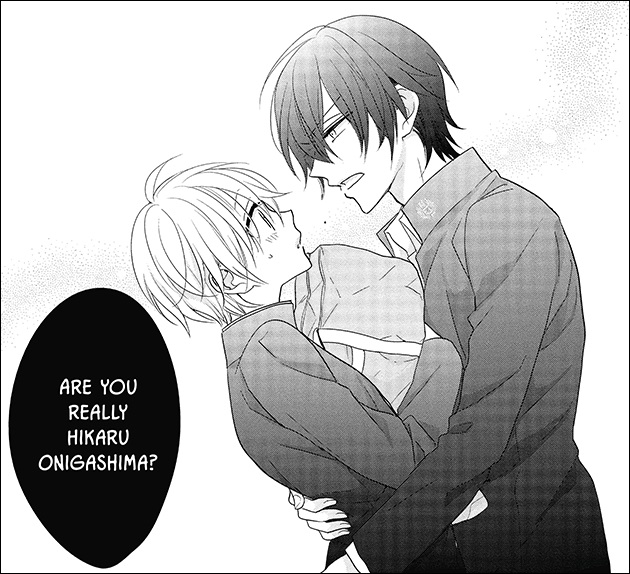
This all comes to a head when she bumps into him in her casual, normal attire outside of the Academy when visiting the orphanage to pick up her favourite stuffed animal that she had accidently left behind. While there, she notices a young boy bullying a younger girl, and attempts to intervene — until she notices Rintaro stopping the boy instead.
Up until this point, Rintaro knew who Hinako was, but the opposite wasn’t true; it’s here that he tells her outright, though, noting that “there’s no way I’d mistake you for [Hikaru]”. He doesn’t want to see her get hurt, not just because he cares for her, but because he feels like he failed to protect her as a kid. This, of course, puts her mission to fight everyone in the Academy, come out on top and advance in the ranks in a bit of a difficult situation.
The volume ends on a lovely note after a bit of conflict here, with both Hinako’s male friend group, and between-chapter comic relief providers Hikaru and his caretaker Sakaguchi Haruo noticing her unspoken but obviously downcast feelings about her upcoming fight with Rintaro. They attempt to cheer her up either by buying more stuffed toys for her, or spending time in the arcades with her to distract her. It’s all the encouragement she needs to realise and accept her newfound mission to protect those she has grown close to by seeing her goal through and becoming the strongest.
The volume’s last page teases us with the final love interest: senpai/ore type Houou Onigashima. Author Chie Shimada accurately notes how we all doubtless feel about him in a sidebar comment that notes “when I see him, I suddenly have this strange desire for him to carry me on his shoulders”.
Well, I don’t know about you, but that’s got me all excited for the second volume — which is also, sadly, the final one. It’s over almost as soon as it’s begun, for shame! But that doesn’t mean you shouldn’t take the time to enjoy it; if you’d like to join the party, kick off with the first volume on Amazon, and join us next time when we discuss the thrilling conclusion!
Join The Discussion
Rice Digital Discord
Rice Digital Twitter
Rice Digital Facebook
Or write us a letter for the Rice Digital Friday Letters Page by clicking here!
Disclosure: Some links in this article may be affiliate links, which means we may earn a small commission if you make a purchase after clicking on them. This is at no additional cost to you and helps support Rice Digital!
- Sigh of the Abyss: Shadow Bonds – Prologue Review - October 7, 2023
- Is She The Wolf? is wickedly addicting TV - October 6, 2023
- The steady consumption of Slow Damage - October 5, 2023





